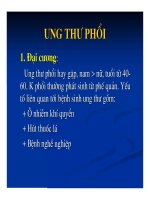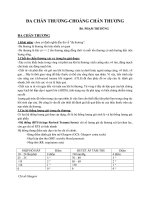Triggers.pdf
Bạn đang xem bản rút gọn của tài liệu. Xem và tải ngay bản đầy đủ của tài liệu tại đây (692.24 KB, 9 trang )
Practice 05. TRIGGER & OTHER CONSTRAINTS
PART 1. Theory Review
CREATE [OR REPLACE] TRIGGER <trigger_name>
BEFORE | AFTER | INSTEAD OF [INSERT] [,] [UPDATE] [,] [DELETE] [OF
<column_name>] ON <table_name>
[REFERENCING
OLD ROW|TABLE AS <variable_name>,
NEW ROW|TABLE AS <variable_name>]
FOR EACH ROW | FOR EACH STATEMENT
[WHEN <condition>]
BEGIN
<statements>
END;
Note: [..]: optional clause
OLD TABLE and NEW TABLE are used in the case FOR EACH STATEMENT (default
mode)
OLD ROW and NEW ROW are used in the case FOR EACH ROW
Example:
Given table:
Trigger 1:
Trigger 2:
Trigger 3:
Part II. Practice with MS SQL Server:
SQL basic Trigger structure
CREATE [OR ALTER] TRIGGER [schema_name.] trigger_name
ON <table_name>
FOR | AFTER | INSTEAD OF
[INSERT] [,] [UPDATE] [,] [DELETE] [OF <column_name>]
AS <sql statements>
Three things to remember:
(1) NO FOR EACH ROW
(2) BEFORE → FOR
(3) NO REFERENCING OLD OR NEW ROW OR TABLE
(4) USE INSERTED and DELETED TABLES for referencing old and new tuples
Examples
Step 1: create sample tables:
CREATE TABLE dbo.SampleTable (
SampleTableID INT NOT NULL IDENTITY(1,1),
SampleTableInt INT NOT NULL,
SampleTableChar CHAR(5) NOT NULL,
SampleTableVarChar VARCHAR(30) NOT NULL,
CONSTRAINT PK_SampleTable PRIMARY KEY CLUSTERED (SampleTableID)
);
GO
CREATE TABLE dbo.SampleTable_Audit (
SampleTableID INT NOT NULL,
SampleTableInt INT NOT NULL,
SampleTableChar CHAR(5) NOT NULL,
SampleTableVarChar VARCHAR(30) NOT NULL,
Operation CHAR(1) NOT NULL,
TriggerTable CHAR(1) NOT NULL,
AuditDateTime smalldatetime NOT NULL DEFAULT GETDATE(),
);
Step 2: Create triggers
CREATE TRIGGER dbo.SampleTable_InsertTrigger
ON dbo.SampleTable
FOR INSERT
AS
BEGIN
INSERT INTO dbo.SampleTable_Audit
(SampleTableID, SampleTableInt, SampleTableChar,
SampleTableVarChar, Operation, TriggerTable)
SELECT SampleTableID, SampleTableInt, SampleTableChar,
SampleTableVarChar, 'I', 'I'
FROM inserted;
END;
GO
CREATE TRIGGER dbo.SampleTable_DeleteTrigger
ON dbo.SampleTable
FOR DELETE
AS
BEGIN
INSERT INTO dbo.SampleTable_Audit
(SampleTableID, SampleTableInt, SampleTableChar,
SampleTableVarChar, Operation, TriggerTable)
SELECT SampleTableID, SampleTableInt, SampleTableChar,
SampleTableVarChar, 'D', 'D'
FROM deleted;
END;
GO
CREATE TRIGGER dbo.SampleTable_UpdateTrigger
ON dbo.SampleTable
FOR UPDATE
AS
BEGIN
INSERT INTO dbo.SampleTable_Audit
(SampleTableID, SampleTableInt, SampleTableChar,
SampleTableVarChar, Operation, TriggerTable)
SELECT SampleTableID, SampleTableInt, SampleTableChar,
SampleTableVarChar, 'U', 'D'
FROM deleted;
INSERT INTO dbo.SampleTable_Audit
(SampleTableID, SampleTableInt, SampleTableChar,
SampleTableVarChar, Operation, TriggerTable)
SELECT SampleTableID, SampleTableInt, SampleTableChar,
SampleTableVarChar, 'U', 'I'
FROM inserted;
END;
Now let's test the triggers:
-- First the inserts
INSERT INTO dbo.SampleTable
(SampleTableInt, SampleTableChar, SampleTableVarChar)
VALUES
(1, '11111', '1111111111');
INSERT INTO dbo.SampleTable
(SampleTableInt, SampleTableChar, SampleTableVarChar)
VALUES
(2, '22222', '222222222222222');
INSERT INTO dbo.SampleTable
(SampleTableInt, SampleTableChar, SampleTableVarChar)
VALUES
(3, 'AAAAA', 'ABCDEFGHIJKLMNOPQRSTUVWXYZ');
GO
-- Check the sample table
SELECT * FROM dbo.SampleTable;
GO
-- Check the inserts
SELECT * FROM dbo.SampleTable_Audit;
GO
-- Perform a delete operation
DELETE FROM dbo.SampleTable
WHERE SampleTableInt = 2;
GO
-- Check the sample table
SELECT * FROM dbo.SampleTable;
GO
-- Check the delete
SELECT * FROM dbo.SampleTable_Audit;
GO
-- Perform an update operation
UPDATE dbo.SampleTable
SET SampleTableChar = '33333'
WHERE SampleTableInt = 3;
GO
-- Check the sample table
SELECT * FROM dbo.SampleTable;
GO
-- Check the update
SELECT * FROM dbo.SampleTable_Audit;
GO
VIEW TRIGGERS CREATED ON TABLES AND SOME ACTIONS ON SSMS
1.
2.
3.
4.
5.
6.
7.
Open SQL Server Management Studio and connect to a server
Open Object Explorer if not open yet
Expand the server node, then databases folder
Expand your database
Expand tables folder
Expand the table you want to check
Expand the triggers folder and will see the list of trigger if any.
You can modify, delete, disable or enable the triggers created by SSMS.
Delete SQL Trigger using Query
DROP TRIGGER [dbo].[triggers_in_sql]
INSTEAD OF TRIGGERS
INSTEAD OF triggers cause their source DML operation to skip and they just execute the
code provided inside them. Actual insert, delete or update operation do not occur at all.
However they have their associated inserted and deleted tables simulating the DML
operation. Inserted and deleted tables are widely used in operations inside triggers and I will
show you some examples below . We will discuss further aspects of INSTEAD OF triggers
by going through some examples for DML operations.
Example 01:
CREATE TABLE BaseTable
(PrimaryKey
int PRIMARY KEY IDENTITY(1,1),
Color
nvarchar(10) NOT NULL,
Material
nvarchar(10) NOT NULL,
ComputedCol AS (Color + Material)
)
GO
--Create a view that contains all columns from the base table.
CREATE VIEW InsteadView
AS SELECT PrimaryKey, Color, Material, ComputedCol
FROM BaseTable
GO
--Create an INSTEAD OF INSERT trigger on the view.
CREATE TRIGGER InsteadTrigger on InsteadView
INSTEAD OF INSERT
AS
BEGIN
--Build an INSERT statement ignoring inserted.PrimaryKey and
--inserted.ComputedCol.
INSERT INTO BaseTable
SELECT Color, Material
FROM inserted
END
GO
Testing your results:
--A correct INSERT statement that skips the PrimaryKey and ComputedCol columns.
INSERT INTO BaseTable (Color, Material)
VALUES (N'Red', N'Cloth')
--View the results of the INSERT statement.
SELECT PrimaryKey, Color, Material, ComputedCol
FROM BaseTable
--An incorrect statement that tries to supply a value for the PrimaryKey and ComputedCol
columns.
INSERT INTO BaseTable
VALUES (2, N'Green', N'Wood', N'GreenWood')
--A correct INSERT statement supplying dummy values for the PrimaryKey and
ComputedCol columns.
INSERT INTO InsteadView (PrimaryKey, Color, Material, ComputedCol)
VALUES (999, N'Blue', N'Plastic', N'XXXXXX')
--View the results of the INSERT statement.
SELECT PrimaryKey, Color, Material, ComputedCol
FROM InsteadView
OTHER PRACTICE
1. Create table according to the below information
EmployeeTable (ID, Name, Education, Occupation, YearlyIncome, Sales)
EmployeeAuditTable(ID, Name, Education, Occupation, YearlyIncome, Sales,
ServerName, ServerInstanceName, InsertTime)
2. Create trigger
-- Example for INSTEAD OF INSERT Triggers in SQL Server
CREATE TRIGGER InsteadOfINSERTTriggerExample on [EmployeeTable]
INSTEAD OF INSERT
AS
BEGIN
INSERT INTO [EmployeeTableAudit](
[ID],
[Name],
[Education],
[Occupation],
[YearlyIncome],
[Sales],
[ServerName],
[ServerInstanceName],
[Insert Time])
SELECT ID,
Name,
Education,
Occupation,
YearlyIncome,
Sales,
CAST( SERVERPROPERTY('MachineName') AS VARCHAR(50)),
CAST( SERVERPROPERTY('ServerName') AS VARCHAR(50)),
GETDATE()
FROM INSERTED
WHERE YearlyIncome <= 70000;
PRINT 'We Successfully Fired Our INSTEAD OF INSERT Triggers in SQL
Server.';
INSERT INTO [EmployeeTable](
[Name],
[Education],
[Occupation],
[YearlyIncome],
[Sales])
SELECT Name,
Education,
Occupation,
YearlyIncome,
Sales
FROM INSERTED
WHERE YearlyIncome > 70000;
END;
3. Lets test your triggers!
====
Exercises:
Use Company database, create triggers as below
1. Employees must have the age greater than 18 when being inserted into database or
updated
2. The location of projects must be in the locations of the department which manages it
3. Create the new table employee_totalhours including ssn, total_emp_hours
Create the trigger which automatically calculates total working hours for employees
over their projects.









